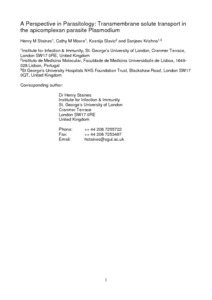Staines, HM; Moore, CM; Slavic, K; Krishna, S
(2017)
Transmembrane solute transport in the apicomplexan parasite Plasmodium.
Emerging Topics in Life Sciences, 1 (6).
pp. 553-561.
ISSN 2397-8554
https://doi.org/10.1042/ETLS20170097
SGUL Authors: Staines, Henry Michael
![[img]](http://sgultest.da.ulcc.ac.uk/109717/1.hassmallThumbnailVersion/Staines%20et%20al%202017.pdf)  Preview |
|
PDF
Accepted Version
Available under License ["licenses_description_publisher" not defined].
Download (300kB)
| Preview
|
Abstract
Apicomplexa are a large group of eukaryotic, single-celled parasites, with complex life cycles that occur within a wide range of different microenvironments. They include important human pathogens such as Plasmodium, the causal agent of malaria, and Toxoplasma, which causes toxoplasmosis most often in immunocompromised individuals. Despite environmental differences in their life cycles, these parasites retain the ability to obtain nutrients, remove waste products, and control ion balances. They achieve this flexibility by relying on proteins that can deliver and remove solutes. This reliance on transport proteins for essential functions makes these pathways excellent potential targets for drug development programmes. Transport proteins are frequently key mediators of drug resistance by their ability to remove drugs from their sites of action. The study of transport processes mediated by integral membrane proteins and, in particular, identification of their physiological functions and localisation, and differentiation from host orthologues has already established new validated drug targets. Our understanding of how apicomplexan parasites have adapted to changing environmental challenges has also increased through the study of their transporters. This brief introduction to membrane transporters of apicomplexans highlights recent discoveries focusing on Plasmodium and emphasises future directions.
Statistics
Item downloaded times since 12 Apr 2018.
Actions (login required)
 |
Edit Item |


